
Have you ever sat back and watched a baby or toddler examine their fingers? They flex one digit at a time and carefully observe how each one moves. They touch and twist and tug until they’re satisfied that they know everything there is to know about those amazing fingers. As they grow, of course, they’ll learn more about what they can do with their fingers and, of course, with their entire hand.
It’s very easy to see how some parts of our body move and work simply by observing these parts. Other body parts, like the spine, are more difficult to understand. So when your patients stare at you with a perplexed look as you attempt to verbally explain the particulars of spine movement, perhaps using your hands and maybe a poster or drawing, chances are they haven’t gotten the picture.
Suppose you’re trying to explain spinal instability. What will you say? Most likely something like “spinal instability is caused by abnormal movement between one vertebrae and another.” Maybe you’ll include the fact that when a disc bulges due to degeneration, increasing movements take place between the vertebrae, causing discomfort. And, of course, when you lose disc height the facet joints become displaced and lose their correct alignment.
Even if the patient is shaking their head in a positive motion during your lengthy discourse, chances are they’re feeling no more educated about spine movement then before your explanation. That means you’ll need something more…and that something more should be a detailed spine model that the patient can observe as well as touch and manipulate.
Dynamic Disc Designs (ddd) makes the models you need for a clear demonstration of spine movement. With these fully-dynamic 3D models, you can point out what’s gone wrong, why symptoms occur, and what the patient can do to fix their problem and, hopefully, continue living pain-free. In turn, your patients can hold the model in their hands, move the parts and see how they work, and – before long – they’ll have that one single moment of clarity where the particulars of spine movement come into focus. From that point on, it’s likely they’ll be able to understand most of your verbal explanations…but if they don’t, you can always use the model again!
The Professional LxH model is one of ddd’s best-selling products. More and more chiropractors, spine surgeons, physiotherapists, massage therapists, and other spine specialists purchase this model each year in hopes of putting their patients at ease by helping them understand their spine problems. With the use of this and other Dynamic Disc Design models, medical professionals create patient-doctor relationships that include trust; the patient can trust in the knowledge that the doctor is well-aware of how to handle their problem and can get them to a point where they begin to feel better.
“Having an accurate and interactive model available to help convey pathomechanical and pathophysiological concepts is extremely valuable,” says chiropractor Cameron M. Brown. “I believe the ddd models enable me to quickly and effectively educate my patients, allowing me to better manage inappropriate attitudes and beliefs concerning their diagnosis, treatment options, and subsequent prognosis.”
Share Now